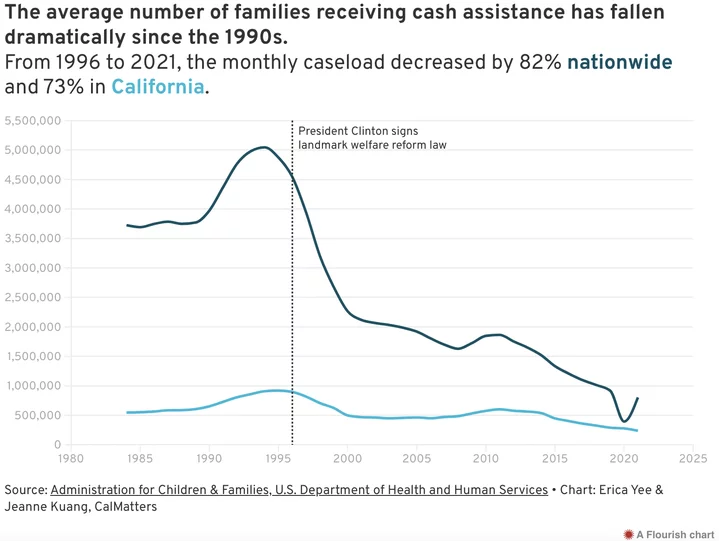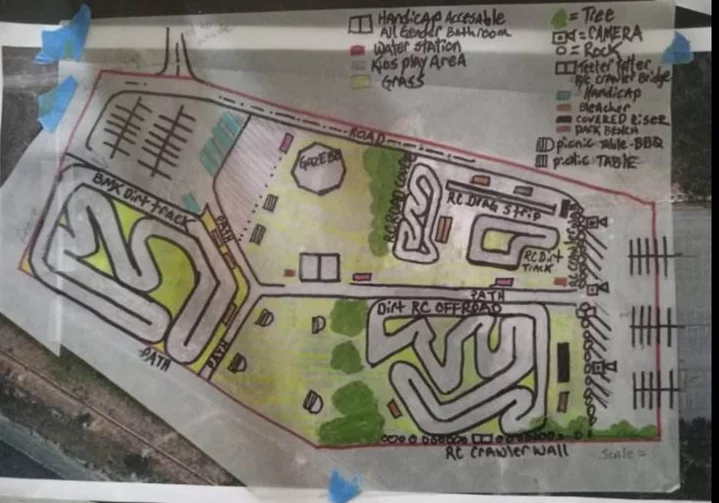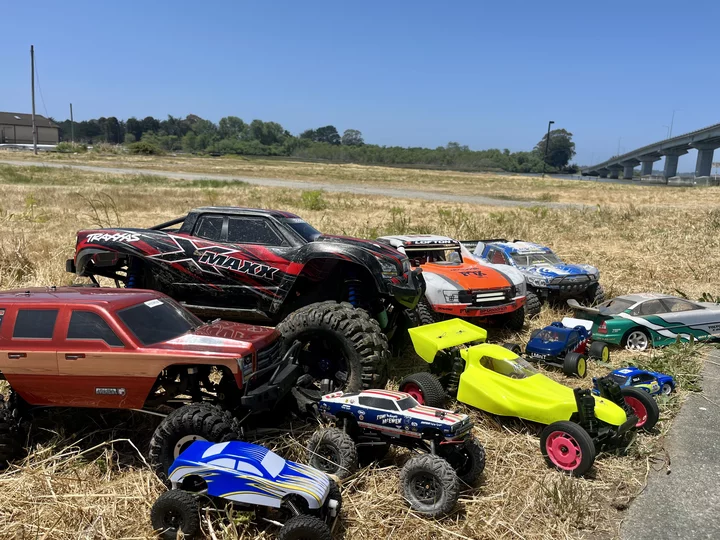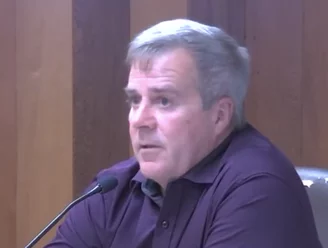Welfare: As US Tightens Work Rules, California Considers Loosening Them
Jeanne Kuang / Friday, June 2, 2023 @ 7:40 a.m. / Sacramento
Illustration by Miguel Gutierrez Jr. | CalMatters; iStock
###
Just as Republicans in Congress are moving to beef up work requirements for people who receive welfare, California lawmakers are moving to do the opposite.
Included in a recent state Assembly budget proposal, and in a bill the Assembly passed on Wednesday, is a plan to remake CalWORKs, the state’s federally funded cash welfare program that requires recipients to work or search for jobs using a list of approved activities.
Under the proposed state changes, recipients would gain greater flexibility to participate in activities such as going to school, domestic violence counseling, addiction treatment or mental health care. The proposal, estimated to cost $100 million, also would lessen financial penalties if recipients violate work rules.
That would make it likely that fewer recipients would get jobs and more likely California would miss a key federal work standard, for which it could be fined.
The goals of the proposed changes are to address practical barriers to employment that CalWORKs recipients – some 340,000 of the poorest families in California – experience, and make it easier for more families to qualify for cash assistance.
And, to prod California’s 58 county social service agencies to carry out the plan, the proposal also would shield counties from potential federal fines.
The efforts come at a fraught moment in a decades-old national debate: Should welfare be a flexible source of emergency aid for families in financial crisis, or an engine to push low-wage single parents to join the workforce?
Congressional Republicans, led by House Speaker Kevin McCarthy of Bakersfield, have pushed to institute stricter welfare work requirements in a bill to raise the nation’s debt ceiling.
Welfare’s work targets
The deal McCarthy struck with President Joe Biden — which the House passed Wednesday and the Senate Thursday night — includes changes in federal welfare rules that would make it harder for California to make its work rate meet federal targets. Failing to meet that work metric could cost the state $185 million out of the $3.7 billion a year it gets in federal welfare grants.
In previous years the federal government has threatened California with fines but never forced the state to pay them, advocates say.
Officials at the California Department of Social Services declined repeated requests for an interview about the state’s welfare policies.
‘We keep people just above drowning. To stabilize families, to allow them to pull themselves up this ladder — this doesn’t do it.’
—Nolo Sullivan, director of Yolo County’s Health and Human Services
For years advocates have pushed to extricate CalWORKs from the strict federal welfare-to-work rules of the 1990s. Those rules touched off dramatic declines in families receiving public assistance and defined the nation’s cash aid system for a generation.
Proponents of work requirements — Republicans and Democrats alike during the 1990s — said people using social safety net programs should be required, or prodded, to work. They said it would ultimately reduce poverty and dependence on public benefits.
A landmark federal law in 1996 began requiring each state to certify that certain percentages of cash aid recipients were working, or participating in a specific list of job search activities, for the state to continue receiving federal welfare grant dollars.
Though welfare rolls fell, poverty didn’t.
Federal reports show declines in welfare enrollment after 1996 did not come with corresponding drops in the number of families poor enough to qualify for welfare. Though caseloads also plunged in the Golden State, today families getting cash aid in California make up nearly a third of the nation’s beneficiaries.
Clashing ideas
Research shows that work requirements led to some increase in employment in the 1990s, but evidence from more recent years is less clear, partly because so many people left the welfare program. A Congressional Budget Office review this year found a “substantial” increase since the 1990s in single mothers who have no income from either work or cash aid.
Advocates have long called work requirements counterproductive and racist, based on stereotypes about “welfare queens” who refuse to work.
California’s cash aid program has been caught between the two ideologies. The state never fully embraced the strict policies of 1996.
While many states slashed welfare rolls — opting instead to use their federal grants on other programs — California continued giving cash assistance. Unlike some other states, California kept cash aid going to children even after their parents’ benefits were cut for violating program work rules.
California also exempts many families from work rules. For those subject to them, the state in 2012 created a more flexible list of activities beyond the strict federal definitions of work.
The state is risking that some recipients won’t count toward the federal work metric. It’s a path other liberal states have taken, said Heather Hahn, a national expert at the Urban Institute.
“States are doing these things that can be seen as workarounds, because working with the (federal rules) feels counter to their goals of helping people achieve economic success,” Hahn said.
A chance at college
More notably, some low-income parents in California receive cash aid while attending college, which counts toward the state’s work rules.
That has been a lifeline for Summer Pratt.
The 42-year-old mother in Grass Valley signed up for CalWORKs upon enrolling at Sierra Nevada College. She had two children to support and no income after getting divorced. She is studying early childhood development and business entrepreneurship — first steps in her plans to open a home-based daycare.
“The money itself has been a tremendous help in allowing me time with my kids and to do schoolwork, and allowing me not to have to go into the workforce yet,” Pratt said.
Advocates and social workers say CalWORKs is far from effective at giving people who must work or search for work a stable, long-term path out of poverty.
“We keep people just above drowning,” said Nolan Sullivan, director of Yolo County’s health and human services agency. “To stabilize families, to allow them to pull themselves up this ladder — this doesn’t do it.”
Yolo County has the highest poverty rate in the state.
To qualify for CalWORKs, a single parent with one child can’t make more than about $1,300 a month. Usually when someone gets into the program, that person is already deep in poverty, given California’s high cost of living, Sullivan said, and many come with significant trauma.
Advocates say recipients face steep barriers to finding and keeping stable jobs that pay enough to raise children. State figures show 45% of the people required to participate in work activities don’t have a high school diploma.
Many need child care and transportation. One in five has experienced domestic violence, and nearly a third report mental health challenges, according to the California Budget and Policy Center.
At work but poor
Cathy Senderling, director of the California Welfare Directors Association, said giving recipients experiencing those challenges a list of required activities can create “adversarial” relationships with social workers.
Parents can be on CalWORKs for up to five years. Those who leave and find work often bring home low earnings.
Just before the pandemic upended the economy, 18,000 former welfare recipients made income from jobs a year after leaving CalWORKs, according to California’s Department of Social Services. In the first three months of 2020, those former recipients earned an average of $5,800 — about $23,000 annually.
Assemblymember Joaquin Arambula, a Fresno Democrat, and advocates are pushing a proposal that loosens many of the state rules in favor of a more individualized approach.
Instead of giving recipients a list of allowable welfare-to-work activities to complete, county social workers would come up with a plan that takes into account recipients’ individual circumstances and addresses needs for child care, mental health care or other social services.
“Today counties are asking recipients to meet certain requirements, and we’re saying recipients should be able to come to counties and say, ‘These are the things I need as a family first,’” said Christopher Sanchez, a policy advocate at the Western Center on Law and Poverty.
Culture shift
The state proposal includes paring back sanctions, which are penalties counties impose on recipients who don’t follow their welfare rules. Sanctions come in the form of cutting off cash aid for the adult; advocates say it’s counterproductive to punish struggling families by further restricting benefits.
Arambula’s proposal would essentially eliminate sanctions if recipients can’t complete their plans because of a lack of child care, or “physical, mental, emotional, or other family circumstances.”
Like all major changes in social services, how this policy gets implemented would depend on the county welfare agencies responsible for the rollout.
Sullivan, in Yolo County, said some caseworkers believe the threat of sanctions is “one of the only tools they have to get people to change their lives.”
He predicted the proposal would run into a cultural divide among county caseworkers, who are split on how rigid and rule-based welfare should be.
“You can’t legislate a culture shift,” he said.
###
CalMatters.org is a nonprofit, nonpartisan media venture explaining California policies and politics.
BOOKED
Yesterday: 9 felonies, 10 misdemeanors, 0 infractions
JUDGED
Humboldt County Superior Court Calendar: Today
CHP REPORTS
Us101 N / Westhaven Dr Ofr (HM office): Trfc Collision-1141 Enrt
ELSEWHERE
Mad River Union: One year until Humboldt’s budget ‘up a creek’
Mad River Union: Arcata Fire’s popular services exceed its available resources
Mad River Union: Blue Lake hires Jennie Short as city manager
Mad River Union: ‘Random dude’ with knife attempts McK robbery
OBITUARY: Larry Charles Bacchetti, 1938-2023
LoCO Staff / Friday, June 2, 2023 @ 6:56 a.m. / Obits
My beloved husband Larry Charles Bacchetti passed away at Kaiser Hospital
with his wife, Mary, at his side on April 21, 2023.
Larry spent the first 30 years of his life in Eureka. At the age of 10 his mother died unexpectedly. It was a difficult time for his father, with five children to care for. At that time only social security was paid to the head of the household. Larry, at 13, feeling the need to help his father, went to work for Dick Kreps Lumber Yard. At 35 cents an hour, Larry would give half his paycheck to his father. Larry was a fast learner and to this day could figure how many square feet in a board without a computer. Before long Dick would leave him in charge. This helped to build the strong work ethic that Larry had his whole working career. Another, always being on time.
At the age of 16, he went to work in the mail room for the Eureka Times-Standard newspaper. Turning 18, it opened the opportunity to applied for a pressman apprenticeship program at the Times Standard — a career he followed his entire life. During that time, he met and married his wife, Mary Senn, having two children, Gregory & Brenda.
Larry loved ocean fishing with his buddy Ken Van Pelt. Larry also built a smoke house in his backyard. Ask Arnie Millsap or Doug Curtis what happened one night? Or perhaps the Eureka Fire Department? In Eureka, he served in the National Guard, spending two weeks at Camp Roberts every summer. He was an active member of the Eureka 20-30 club and served as President. Also he served as president of Night-Out Dance Club, with Al Sanders his VP. A fun time with dances held once a month at the Moose Lodge.
Things were changing in the newspaper industry. No more afternoon paper. It was becoming a night operation. 1969 finds Larry and family living in the Seattle area and working for the Post-Intelligencer. In 1970 Larry moves back to California and starts his tenure at the San Jose Mercury News. It’s a total night operation. By 1984 he was promoted to pressroom operations manager, a position he held until his retirement on Jan. 1, 2000.
In 1985 Larry & Mary purchased property in Mattole Valley. Larry’s best friend, Jerry Ballard, named the farm the “Bacchetti Fun Farm” — a place to go & have “FUN,” and that we did! Eight couples gathered for 25 years over the Labor Day weekend. A theme was adopted every year and two couples planned all the activities & food for the day. Unfortunately, on March 3, 2021, a fire destroyed the main house, luckily leaving all the outbuildings intact.
Larry loved road trips with adventure at every stop. Baja California was one of his favorites, along with 30 days in New Zealand. As he aged, cruises were on the horizon. Trips included Italy, Panama Canal, Alaska and down the East Coast, to name a few. However, his first real love was at his farm in Mattole Valley. He always had something on the drawing board. A party kitchen, a gazebo, a bunk house and a big barn. He also built a room for Mary’s canned goods, leaving enough room for his wine. It was well insulated, and a good place to cool off when the temps hit 100 or more. He planted a family orchard and in summertime a garden. His tomatoes were the best. The grandkids loved the pumpkins and let’s not forget the apples! Mary canned everything. Time out was walking or swimming in the Mattole River. Returning to BBQ and a cool cocktail under one of their many shade trees.
The final chapter found Larry & Mary living in Lincoln, Calif. — a lovely retirement. community with many things to keep one occupied. We are member of the Italian Club, which has social gatherings once a month. Can’t forget the neighborhood “Mailbox Gang.” Life is never boring!
Larry is preceded in death by his parents, Angelo & Shirley Bacchetti, Stepmother Grace (Ronnie) Bacchetti, Brother Bruce Bacchetti. Survived by Wife Mary of Lincoln & Petrolia, Son, Gregory Bacchetti, Petrolia, Daughter Brenda Criley, San Jose, Brothers Duane of Olympia, WA, Frederick (Judy) Bacchetti, Woodburn, OR and Sister Donna Millsap of Eureka. Grandchildren, Davin Bacchetti (Desiree) Bacchetti, Andrew Criley, and Erica Criley. Great Grandchild Reign Ruiz all of San Jose, CA Granddaughter Christine Kaundart of Canton, GA
Larry will be interred at Ocean View Cemetery in Eureka. A celebration of life is scheduled in Eureka. There will be a celebration of life at the Wharfinger Building on June 23 at 1 p.m. Please RSVP by June 11 if you wish to attend. To do that, or for more information, contact Mary at: bacchetti1@gmail.com.
In lieu of flowers, the family prefers a donation in Larry’s honor to the Mattole Valley Historic Society. See this link, or write to PO Box 144, Petrolia, CA, 95558.
###
The obituary above was submitted on behalf of Larry Bacchetti’s loved ones. The Lost Coast Outpost runs obituaries of Humboldt County residents at no charge. See guidelines here. Email news@lostcoastoutpost.com.
OBITUARY: Eric Douglas (‘Rick’) Tyson, 1959-2023
LoCO Staff / Friday, June 2, 2023 @ 6:56 a.m. / Obits
Rick passed away on April 20, 2023 at his home in Carlotta. Rick had early onset vascular dementia that progressed rapidly. Rick was born January 4, 1959 in Fountain Hill (near Allentown), Pennsylvania. Rick grew up in a large family. He had six brothers and one sister. He had fond memories about the historic home he grew up in that was built solid, of stone. He always spoke fondly of how his father could fix anything. Rick was proud of his father, Jesse Tyson, who served as a pilot in the US Army Air Corps during WWII. Rick’s father was deployed to England in March 1944. He flew a B26 FLYING Marauder until the end of the war. Rick respected the fact that his father would not speak of the horrible nature of war. He adored his mother, Phyllis Tyson, whom he loved dearly. She provided a loving home for their large family.
Rick graduated from Salisbury High School in 1977. When Rick enlisted in the US Navy he had a plan to further his education. He received a certificate of completion in, “Basic electricity and electronics”, given at the Service School Command Naval Training center in Orlando, Florida. He then completed, Construction Electrician Class “A” School with honors in November 1981. Rick arrived in Humboldt County while proudly serving his country for five years 1981 to 1986, in the United States Navy, stationed at Centerville Beach. He received a Certificate of Completion of 216 hours at College of the Redwoods, in industrial electricity & electronics.
While in the service he met his first wife, Debra Young. They eventually settled in Shively, where they shared a home with their adopted sons Steven and Robert.
Rick worked for Eel River Sawmills as an electrician. He then obtained his contractor’s license and started his own business — Tyson’s Electric Service. Rick had the reputation for getting the job done working with many businesses in Humboldt County. Rick was highly skilled as an electrician and would take the time to teach the colleagues he worked with. He also built complicated computerized timing panels. Rick loved his work and enjoyed the company of the people he worked with.
As life ebbs and flows, relationships end and new ones begin, Rick and I met in the springtime, our favorite time of year, over a cup of coffee. We hit it off like two puzzle pieces fitting together — it felt like we had known each other our whole lives. He showed me his favorite places in Humboldt, which turned out to be mine as well. We both loved and spent time exploring Humboldt, we hiked the Avenue of the Giants, Founders Grove, places off Highway 36 and the area’s beaches. We also loved traveling up Oregon’s coast. We married on June 7, 2003 in Gold Beach, Oregon right on the banks of the Rogue River. We were just two months away from our 20th wedding anniversary when Rick passed away. I will never forget the two weeks we spent working our way up the Oregon coast, exploring every lighthouse along the way, and how patient Rick was with my wanting to climb the stairs to get a view from the top. We also took a few days to go to Las Vegas and took in a show at the Bellagio Resort — Cirque Du Soleil. This was a surprise for Rick because I knew he loved clowns. We were so excited after the show we spent hours discussing our favorite parts and we had to be at the airport at 6 a.m. to go home.
Rick had a good heart and was a giving man. He helped others without asking for anything in return. He always seemed to know what I needed without me asking. One of Rick’s favorite pastimes was reading. He always had a book or two he was involved with. I don’t know how he kept the story lines apart when he read two books at the same time. He liked Stephen King and John Grisham-type books. Rick also loved poetry. He introduced me to EE Cummings and Edgar Allen Poe. He even wrote me beautiful love poems that melted my heart. In 2006 we moved to Carlotta after we purchased an 1870s farmhouse that was a dream come true for the both of us. With over three acres, an old redwood barn and a year-round creek. It doesn’t get better than that. Rick loved mowing the lawn on his John Deere mower, and taking the grandbabies for rides too. He loved growing tomatoes, green beans and other vegetables in the garden. He also loved having a shop he could tinker around in. Just like his dad, Rick could fix anything.
Rick also loved listening to music. He loved classic rock. Bob Dylan was his all-time favorite. After we met I introduced new artists to him. One of his new favorites was Natalie Merchant. He loved watching the DVD I bought for him one Christmas, MTV’S Storybook concert. He said her voice was angelic and it was a must-watch once a year minimum. He put up with my feeding every stray and feral cat that found their way to our farmhouse. But he also loved taking care of them too, which endeared him even more to me.
Rick loved his sons Steven and Robert, he had great stories of their time in Shively. Although my sons Jared and Aaron were in the teenage years when we married, he grew to love them as his own too. Going above and beyond to guide them as they grew into adulthood. He loved having the kids over for weekends, and holiday meals. As the grandbabies were born, he enjoyed watching them grow, he loved being called Papa Rick. He would always have a toy or treat to surprise them. As they grew older he let them ride the John Deer mower.
Rick is survived by his loving wife Lucy Tyson, his step-sons Jared Vleming (Kayleigh), Aaron Vleming (Lisa), grandchildren Carmen, Aaron Jr. and Eddie Jean. First wife Debra Young, his sons, Steven Tyson (Terri) and Robert Tyson. His brothers, Kevin Tyson (Cindy), Jon Tyson (Tracy), and Matthew Tyson (LeAnn), sister Katie Steiner (Tom), and many nephews and nieces.
Rick was preceded in death by his parents Jesse and Phyllis Tyson, his brothers Robbie Tyson, David Tyson and Mark Tyson and granddaughter, little baby Ellie Vleming.
It would be the family’s honor for those who knew Rick to join us for a celebration of life, followed by a Veterans Honors Ceremony provided by The Mad River Community Veterans Honor Guard, at 175 Wilson Lane, Carlotta, off of Highway 36, on Friday, July 28, 2023 at 1 p.m. I would like to thank the incredible staff at Hospice of Humboldt and Christian from Agape Home Health for all the help and care Rick and I received. Because of their support, I was able to care for Rick in our home. Funeral arrangements provided by Goble’s Fortuna Mortuary.
Ricky, I will carry you in my heart forever, I love you!
“[i carry your heart with me(i carry it in],” by ee cummings
###
The obituary above was submitted on behalf of Rick Tyson’s loved ones. The Lost Coast Outpost runs obituaries of Humboldt County residents at no charge. See guidelines here. Email news@lostcoastoutpost.com.
OBITUARY: Herbert Orvis (Tex) Box, 1934-2023
LoCO Staff / Friday, June 2, 2023 @ 6:56 a.m. / Obits
Dad went to be with the lord on May 23, 2023. Dad passed peacefully in his sleep and is now free of pain and joyfully reunited with our mom, Arlene and other family members.
Dad was born in Lockney, Texas on January 3, 1934 to Paul and Edith Box. Paul and Edith had four children, Tex being the only son.
In 1945 the family relocated to Korbel. At past family gatherings many fond memories were shared of the years spent in Korbel.
Dad attended grammar school in Korbel and was a 1951 graduate of Arcata High School. Dad lettered in multiple sports while attending Arcata High.
In 1951 at the young age of 16 and 17 Mom and Dad were married and spent the next 60 years together until Mom’s passing in 2012. In 1952 their first son (Bobby) was born, followed by two daughters (Mona and Cindy). Two more sons (Monte and Lonnie) completed the family.
Dad worked for Simpson Timber Co. at the Korbel mill for 33 years until his retirement as production scheduler in 1984.
Dad was an avid hunter and a skilled athlete, playing on and coaching for many Blue Lake teams over the years. His hunting skills cans be attested to by the many deer racks displayed on the walls and in the patio of his home. These skills and traits he passed on to his sons and grandsons.
Dad is survived by his children Bobby (Marie) Box of Mckinlleyville, Mona Hill of Cottonwood, Cindy Box of Blue Lake, Monte (Teresa) Box of Fortuna, Lonnie (Linda) Box of Arcata and Greg Perry of Hoopa. Dad is also survived by sisters Greta Box and Martha Taylor; grandchildren Heidi and Terrence Box, Clayton and Tory Swift, David Duran, Travis Toledo, Lindsey Toledo Titus, Sarah Purvis, Casey and Cody Box; 24 great-grandchildren and one great-great-grandson.
Dad was laid to rest along side our mom, Arlene, at Sunset Memorial Park on Thursday June 1, 2023.
Burial arrangements were handled by Paul’s Funeral Chapel.
The family would like to thank everyone for prayers and well wishes.
###
The obituary above was submitted on behalf of Herbert Box’s loved ones. The Lost Coast Outpost runs obituaries of Humboldt County residents at no charge. See guidelines here. Email news@lostcoastoutpost.com.
HUMBOLDT TODAY with John Kennedy O’Connor | June 1, 2023
LoCO Staff / Thursday, June 1, 2023 @ 4:20 p.m. / Humboldt Today
NEWS: The details of Eureka’s new draft budget for 2023-2024, grumbling about Gav’s state of the state roadshow, bucks for Hoopa Valley climate change adaptation, Redwood Coast Energy Authority honored, local person honored as a Changemaker, new wrestling program at CR, World Oceans day at the Trinidad Rancheria … and more!
Press play above, and stick around for the poll below!
VROOM VROOM! This RC Car Nerd is Working With the City of Eureka to Build an Outdoor Off-Road RC Track
Stephanie McGeary / Thursday, June 1, 2023 @ 12:57 p.m. / Event , Our Culture
Meet Andrew Howard, Eurekan, father, RC car guy | Photos/video: Stephanie McGeary
###
Andrew Howard, a 35-year-old lifelong Eureka resident, has been interested in cars almost his entire life. Growing up with a car enthusiast father, Howard started learning about classic cars at a young age, and was working on his first car – a ‘73 Plymouth duster – by the time he was 12 years old.
As an adult, Howard still collects and works on muscle cars from the ‘60s and ‘70s, but has also developed an interest in much smaller vehicles – radio controlled (RC) cars. Now his hobby has turned into a passion project and the City of Eureka is working with Howard and some other RC enthusiasts to build an outdoor RC racing track in Eureka.
“[I’ve] been working with the city for a little over a year to get something going,” Howard told the Outpost during an interview at Halvorsen park on Wednesday. “The city is scouting locations … . It would be really nice to see an area that’s rundown become something that’s really nice.”
Howard said that his love for RC cars really grew during the onset of COVID-19. Like many folks, Howard was looking for an outdoor activity that was safe to do during the pandemic. He took up the hobby with his son, who is now 11, and found it was a great way to get outside and have some fun during lockdown. He started with a couple of cars and now has a collection of around 60 RC vehicles ranging in size and abilities.
Eventually Howard started thinking that there must be others in Humboldt who share his passion for piloting tiny cars, so he started the Facebook group 707 Humboldt R/C Vehicles, which now has 380 members. Howard started connecting with other RC hobbyists and holding group meetups in outdoor spaces to drive and race their vehicles. Sometimes up to 20 people would meet at a time, Howard said.
Howard also works on RC vehicles, fixing broken ones or making modifications and improvements. As he was trying to get people out to race with him, many people said they had an old RC car, but that it had been broken for a long time and they couldn’t use it. Howard said that there is no other place locally that works on RC cars, so he started offering the service and said he has helped get around 200 cars “back on the road.”
“I’ve created a little niche,” Howard said. “Fixing them up is definitely one of the funnest parts.”
One of the places the group liked to use their cars was in a section of Sequoia Park, but after some community members complained, the City asked the RC group to stop running their cars there. Instead, city staff suggested a different solution — that they work together to find a suitable location to build an official racing track.
Because the city had also had similar complaints about BMX (bicycle motocross) and there is currently no designated off-road bike track in Eureka, staff also suggested that the RC folks combine efforts with the BMX community to design a park that would have both an outdoor RC racing track and a BMX track, and the concept for the Eureka Off-Road R/C Track was born.
The project is still in the very early planning stages, Howard said, and a location for the track has not been nailed down yet. But staff from Eureka’s Community Services Department have been working with Howard and have identified a few possible locations, including near the PALCO Marsh behind the Bayshore Mall in the area previously known as Devil’s Playground.
Howard added that he is still trying to find some BMX enthusiasts to get involved with the project planning, since that is not really his area of expertise.
A sketch done by Howard of a potential park design that would include the two tracks and other amenities
The other thing that the project needs, of course, is funding. Howard said city staff is working to find grant funding for the project, but to get things off the ground, the City is hosting a fundraising event on July 9 at the Eureka Municipal Auditorium. The event will be from 10 a.m. to 4 p.m. and will feature two indoor racing tracks – one for 1/10 scale RC cars and one for 1/18 scale cars – as well as a course for RC crawlers. There will also be an RC car show, and attendees will have the opportunity to vote for their favorite car, based on its looks, style and quality. The car show can also feature RC vehicles that are a little too big to race on the tracks.
The event is free to enter, with a suggested donation, and will also feature raffles, food and drinks. All of the proceeds will go toward funding the Eureka Off-Road R/C Track project. Howard wanted to mention that he is still looking for donations for the raffles and food vendors. If you would like to help out or have any questions about the event you can contact Howard at (707) 616-9188.
Howard also emphasized that this event is for anyone in the community to attend, not just RC nerds like himself. And yes, Howard is fully aware that his hobby might seem a bit nerdy. But he loves it and is completely fine with the label.
“When you’re out there having fun and you see other people seeing you and laughing at you having fun, you’re like, ‘Yeah, I look like a nerd.’ But, you know what? I’m having a good time, so it’s okay.”
just a few of Howard’s RC vehicles
Eureka Can Look Forward to a $1.4 Million Budget Surplus Balanced Budget in the Upcoming Fiscal Year, Staff Says
Isabella Vanderheiden / Thursday, June 1, 2023 @ 9:53 a.m. / Local Government
Screenshot of Tuesday’s special Eureka Council meeting.
[CORRECTION: Oops! We misinterpreted some information in the city’s budget. The City of Eureka’s general fund will not have a $1.4 million surplus in the upcoming fiscal year as originally stated. Essentially, the budget will be balanced, according to staff. The Outpost deeply regrets this error.]
###
It’s that time of the year again: Budget season!
The Eureka City Council met for a special meeting on Tuesday evening to take a look at the proposed budget for the upcoming fiscal year and review the status of the city’s major funds.
How are Eureka’s finances shaping up so far? By and large, the city is doing quite well.
“There aren’t many changes expected in the 2023-24 fiscal year in terms of the financial health of the city,” Eureka’s Finance Director Lane Millar told the Outpost. “Our sales tax revenues weren’t as good as they were last year. You know, everything went up during the pandemic but things have gone down since and kind of come back to normal. Things are looking good.”
The general fund – the city’s primary operating fund – grew by approximately $1.5 million in the current fiscal year but revenues are not expected to grow in the 2023-24 fiscal year due to increasing expenditures.
“The [general] fund has a surplus, but a much smaller surplus than the current fiscal year,” Millar said. “Overall expenditure growth is not exceptional nor unexpected due to salary increases that were approved in prior years. … Surpluses are nice to have because they add to the city’s reserves, but just having a balanced budget is also a good thing.”
The Eureka Police Department is projected to receive $16,085,838 from the general fund, up by a little over $500,000 from the current fiscal year. Similarly, the contributions to Humboldt Bay Fire, which receives about 65 percent of its funding from the city, have grown by about $200,000.
The city’s government and administration fund has increased by approximately $300,000, or seven percent, from the current fiscal year. The most notable increase in expenditures goes to the mayor’s division, which more than doubled, at 115 percent.
During Tuesday’s night’s meeting, Millar took questions from councilmembers about the budget adjustments – including about why so much more money was going to the mayor’s office.
He noted that the seemingly drastic increase “has nothing to do with any changes in the mayor’s office.” Rather, it highlights the “high costs for healthcare that the city pays.”
“When we started this fiscal year, [Mayor Kim Bergel] did not have health insurance [through the city],” Millar explained. “And now – starting in 2023-24, they took advantage of our health insurance plans and the cost of the family plan to the city is about $20,000 [annually]. So, you can see how that can really affect a small budget.”
Revenues are up for the water and wastewater funds following the adoption of the new rate study that was approved at the end of last year, Millar said. Water fund expenditures are down, largely due to “transfers,” which are monies used for capital projects. In contrast, transfers have caused wastewater fund expenditures to go up.
The harbor fund is up as well. Revenues are up due to an increase in rent and lease revenues and, overall, the fund has a pretty balanced budget, he said.
Revenues are down in the building fund due to a smaller subsidy from the general fund. Expenditures are down as well, which Millar attributed to efficiencies within the department.
“The building fund has two divisions and two departments, but the main operation is the building division within development services,” he said. “Their budget is dropping significantly. About $200,000 of [their budget comprises] two positions that [the city is] not funding in 2023-24. … We’re not eliminating positions, but we’re not funding them because we don’t anticipate filling those positions next fiscal year.”
Councilmember Kati Moulton asked Millar to elaborate. City Manager Miles Slattery jumped in and explained that the city’s new building official Brendan Reilly “has made drastic changes to that division” in the last year and a half to increase efficiencies throughout the department.
“We’ve kept those positions in place just in case we were to see an uptick or a need for those and, according to the chief building official, we do not right now,” Slattery said.
Turning back to the harbor fund, Councilmember Leslie Castellano asked if there would be funding available for improvements at the marina near the Wharfinger Building. “Folks residing at the public marina have reached out to me in the past year just about, you know, requesting improvements to the facilities and I just want to make sure that those are included in the budget,” she said.
Slattery said the city has already initiated some improvements at the public marina, but added that it has “opened up a can of worms” and is costing the city more money than anticipated.
“A lot of the issues we have with the harbor fund is that there’s a lot of long-standing leases that we’ve had that weren’t at market rate for a very long time and some of them were coming up,” he continued. “And I think that that’s an area where we can improve in order to get better market rate for some of the properties that we do have. But I can assure you that every dime that we get out of the harbor fund goes back into the harbor.”
Millar also went through funding allocations from the American Rescue Plan Act, or ARPA. The city received nearly $6.4 million in ARPA funds from the federal government during the COVID-19 pandemic and has only used $230,000 of that money to date. There are several projects planned for the remaining funds, including wastewater projects, enhanced broadband infrastructure, street reconstruction, fire station improvements and allocations to the city’s housing trust fund, among others.
After a bit of additional discussion, the council agreed to accept the report but did not take any further action on the item.
The next budget discussion on June 20 will focus on reserves, Measure H spending and city employee pensions, or CalPERS.
###
DOCUMENT: Proposed Budget for Fiscal Year 2023-24











